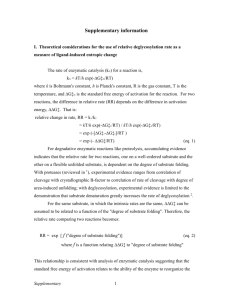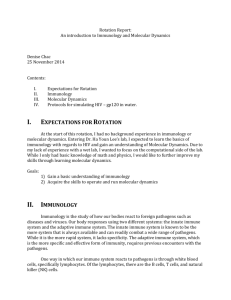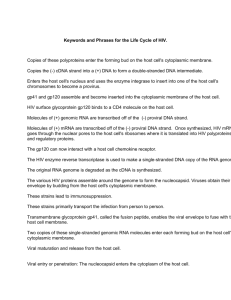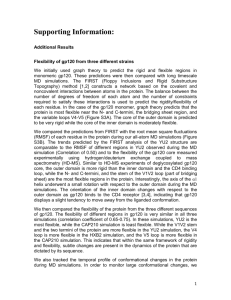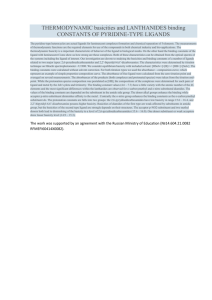Summary of data from deglycosylation assay:
advertisement
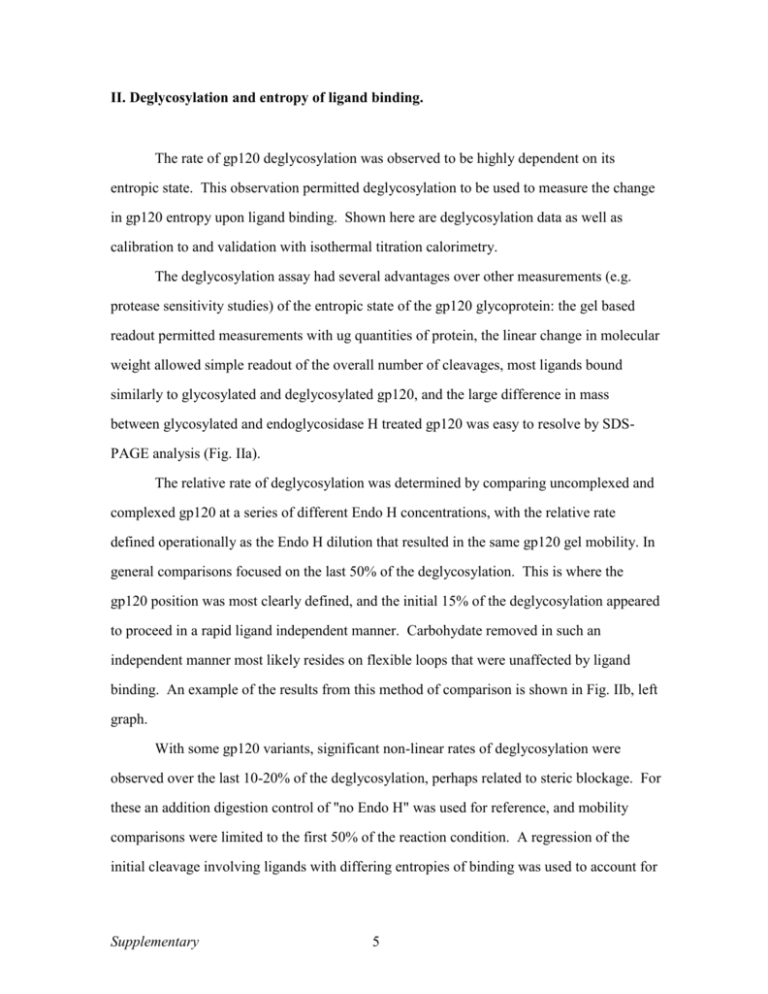
II. Deglycosylation and entropy of ligand binding. The rate of gp120 deglycosylation was observed to be highly dependent on its entropic state. This observation permitted deglycosylation to be used to measure the change in gp120 entropy upon ligand binding. Shown here are deglycosylation data as well as calibration to and validation with isothermal titration calorimetry. The deglycosylation assay had several advantages over other measurements (e.g. protease sensitivity studies) of the entropic state of the gp120 glycoprotein: the gel based readout permitted measurements with ug quantities of protein, the linear change in molecular weight allowed simple readout of the overall number of cleavages, most ligands bound similarly to glycosylated and deglycosylated gp120, and the large difference in mass between glycosylated and endoglycosidase H treated gp120 was easy to resolve by SDSPAGE analysis (Fig. IIa). The relative rate of deglycosylation was determined by comparing uncomplexed and complexed gp120 at a series of different Endo H concentrations, with the relative rate defined operationally as the Endo H dilution that resulted in the same gp120 gel mobility. In general comparisons focused on the last 50% of the deglycosylation. This is where the gp120 position was most clearly defined, and the initial 15% of the deglycosylation appeared to proceed in a rapid ligand independent manner. Carbohydate removed in such an independent manner most likely resides on flexible loops that were unaffected by ligand binding. An example of the results from this method of comparison is shown in Fig. IIb, left graph. With some gp120 variants, significant non-linear rates of deglycosylation were observed over the last 10-20% of the deglycosylation, perhaps related to steric blockage. For these an addition digestion control of "no Endo H" was used for reference, and mobility comparisons were limited to the first 50% of the reaction condition. A regression of the initial cleavage involving ligands with differing entropies of binding was used to account for Supplementary 5 the initial ligand independent cleavage. For full-length HXBc2, using 10 different ligands, this initial ligand independent cleavage accounted for 16.4±0.3% of the carbohydrate, corresponding to roughly 2 sites of N-linked attachment. An example of this method of comparison is shown in Fig.IIb, right graph. Data from five deglycosylation experiments are presented -- two with full-length HxBc2, two with YU2 (core + V3 loop) and one with JRFL (core + V3 loop). Shown are relative rates of deglycosylation for each ligand. Also shown are the entropy values (T∆S) determined by isothermal titration calorimetry (ITC) that were used in the normalization procedure. For CD4+17b, 50.4±2.5 represents the mean of the values calculated using two different paths of the CD4:17b thermodynamic cycle (Fig. 2). For CD4, 46.5±5.3 is the average of the two CD4:gp120 values reported here combined with the two published previously 1, with the error being the average difference from the mean for the four measurements. For 17b, 31.5±2.8 represents the mean of the values determined at 37°C (Table 1 and Fig. 2). Other ITC values are reported in Table 1; for the dual measurements with b12 and C11, entropies and associated errors have been averaged (the ITC value for C11 is shown for reference, it was not used in the normalization since the ITC measurements occurred with either b12 or CD4+17b present). Reported errors in relative deglycosylation rates reflected the standard deviation in rate from estimates made at several different Endo H concentrations. For many reactions, up to 3-fold error in rate was estimated from individual measurement; averaging from estimates at several different Endo H concentrations permitted more precise determinations. For gp120 samples that showed small changes in deglycosylation rate with CD4 (e.g. experiment #1, with full-length HXBc2), 100.5 dilutions in Endo H were used. For gp120 samples that showed larger changes in deglycosylation rate, 10-fold dilution in Endo H were used. An added control (no ligand; an additional 100.5 dilution of Endo H) allowed rates to be inferred more accurately. Supplementary 6 If ligand binding greatly alters the overall folding of a protein, theoretical analysis shows that there exists a relationship between entropy of ligand binding and the logarithm of the relative rate of deglycosylation. We fit data to the equation: -T∆S(ligand-binding reaction) = a * log (relative rate of deglycosylation) + b Relatively good fits to this equation were observed with the data in Table IIa (see Fig. IIb which graphs the data from experiments #1 and #3). However, the value for “b” (the intercept at relative rate = 1) deviated significantly from zero, suggesting other influences on the relative rate of deglycosylation. These have several likely sources. First, the rate of deglycosylation correlates with the entropic state of gp120, whereas ITC measures the entropic changes of the entire binding reaction, including those related solely to the antibody or to the solvent. Second, antibody binding affects not only the entropy of gp120, but also its diffusion rate. Third, the degree of deglycosylation is not linearly related to the amount of Endo H over the deglycosylation range (although this could be partially normalized as described in the methods). To aid in the normalization, we used multiple “control” ligands, for which the ITC value of ligand binding had been determined, and included the value "T∆S=0" for "relative rate=1" (with an estimated error equal to the average error of the control measurements). The values of “a” and “b” generated with this normalization procedure using double-error fitting produced the values given in Table IIb. (The R2 residual are the average of the R2 residual in x and y obtained using a double-error fitting procedure, which considered error in both x and y coordinate. With a and b, the entropies of ligand binding could be determined from the relative rate of deglycosylation.) Supplementary 7 Supplementary II Figure legend: Fig. II. Deglycosylation assay and entropy of gp120 binding. a, Deglycosylation assay data. Polyacrylamide gels ( 8-25% gradient) of YU2 gp120 (core + V3 loop) after incubation at 37°C, pH 5.5, 2 hr are shown with varying concentrations of endoglycosidase H (Endo H ) in the presence of various gp120-reactive ligands. b, Calibration. The logarithm of the relative decrease in the rate of deglycosylation of gp120 upon ligand binding (plotted along the horizontal axis) is plotted versus the entropy of gp120:ligand binding as determined by isothermal titration calorimetry (vertical axis). The left hand plot shows YU2 (core + V3 loop) gp120, assayed as shown in a. The right hand plots shows HXBc2 gp120 (WT) assayed at 20°C, pH 6.5, 20 hr. The best-fit line was determined by taking into account errors in measurement from both the calorimetry (vertical error) and kinetics (horizontal error, with error symmeterized after logarithmic transformation to permit double-error fitting). The average R2 residual for the plot on the left is 0.99 with X2 = 1.5. The average R2 residual for the plot on the right is 0.93 with X2 = 5.6. Despite the dramatic difference in relative rates for the two reaction conditions, good correlation is seen between relative rate and entropy. c, Validation. The entropy of ligand binding was determined for eight different ligands and ligand combinations, by both the deglycosylation assay and by isothermal titration calorimetry. Data from four different deglycosylation assay experiments are shown using full-length HXBc2 gp120 (filled circles), core JRFL gp120 with V3 loop (filled squares), and core YU2 gp120 with V3 loop (filled diamonds). These results are plotted against the average isothermal titration calorimetry results obtained on either HXBc2 core or full-length YU2 gp120. Errors from both measurements are shown. A slope of 1.0 and an intercept of 0.0 would show unbiased correlation between the two methods. Double-error fitting for all of the data gave a slope of 0.82 ± 0.10 and an intercept of 4.0 ±2.3, indicating that the Supplementary 8 deglycosylation assay may provide a 4 kcal lower determination of entropy for ligands that bind with low entropy; fitting just the antibody results gave a slope of 0.96 ± 0.14 and an intercept of 2.9 ±2.5. R2 residuals for the double fitting were 0.991 and 0.989 in X and 0.876 and 0.879 in Y for all data and antibody only data respectively. Also shown (open circles) are the values for the deglycosylation assay obtained when each individual measurement was entirely omitted from the normalization between relative rate and calorimetry-derived entropy. The similarity between the "omitted" and "normalizationincluded" data indicated that including each data point in its own normalization did not have a large impact on its value. (Since C11 calorimetry was carried out in the presence of other ligands, it was not used in normalization; thus only an open circle is shown for C11.) References: 1. Myszka, D. G. et al. Energetics of the HIV gp120-CD4 binding reaction. Proc. Natl. Acad. Sci. USA 97, 9026-9031 (2000). 2. Thali, M. et al. Characterization of conserved human immunodeficiency virus type 1 (HIV-1) gp120 neutralization epitopes exposed upon gp120-CD4 binding. J. Virol. 67, 3978-3988 (1993). 3. Posner, M. R. et al. An IgG human monoclonal antibody that reacts with HIV1/GP120, inhibits virus binding to cells, and neutralizes infection. J. Immunol. 146, 4325-4332 (1991). 4. Burton, D. R. et al. Efficient neutralization of primary isolates of HIV-1 by a recombinant human monoclonal antibody. Science 266, 1024-1027 (1994). 5. Moore, J. P. & Sodroski, J. Antibody cross-competition analysis of the human immunodeficiency virus type 1 exterior envelope glycoprotein. J Virol. 70, 18631872 (1996). 6. Trkola, A. et al. Human monoclonal antibody 2G12 defines a distinctive neutralization epitope on the gp120 glycoprotein of human immunodeficiency virus type 1. J. Virol. 70, 1100-1108 (1996). 7. Ditzel, H. J. et al. Mapping the protein surface of human immunodeficiency virus type 1 gp120 using human monoclonal antibodies from phage display libraries. J. Mol. Biol. 267 (1997). 8. Ditzel, H. J. et al. Neutralizing recombinant human antibodies to a conformational V2- and CD4-binding site-sensitive epitope of HIV-1 gp120 isolated by using an epitope-masking procedure. J. Immunol. 154, 893-906 (1995). 9. Ho, D. D. et al. Conformational epitope on gp120 important in CD4 binding and human immunodeficiency virus type 1 neutralization identified by a human monoclonal antibody. J. Virol. 65, 489-493 (1991). Supplementary 9 10. 11. 12. 13. 14. Robinson, J. E., Yoshiyama, H., Holton, D., Elliott, S. & Ho, D. D. Distinct antigenic sites on HIV gp120 identified by a panel of human monoclonal antibodies, abstr. Q449. J. Cell. Biochem. Suppl. 16E, 71 (1992). Moore, J. P. et al. Immunochemical analysis of the gp120 surface glycoprotein of human immunodeficiency virus type 1: probing the structure of the C4 and V4 domains and the interaction of the C4 domain with the V3 loop. J . Virol. 67, 47854796 (1993). Parren, P. W. et al. In vitro antigen challenge of human antibody libraries for vaccine evaluation: the human immunodeficiency virus type 1 envelope. J. Virol. 70, 9046-9050 (1996). Moore, J. P. et al. A human monoclonal antibody to a complex epitope in the V3 region of gp120 of human immunodeficiency virus type 1 has broad reactivity within and outside clade B. J. Virol. 69, 122-130 (1995). Korber, B. T. M. et al. HIV Molecular Immunology Database 1999 (Theoretical Biology and Biophysics, Los Alamos, 1999). Supplementary 10 Table IIa. Deglycosylation assay data. ITC entropy Deglycosylation experiment and protein construct: (kcal/mol) (relative rate of deglycosylation) Ligand -T∆S 1. HXBc2* 2. HXBc2 3. YU2# 4. YU2 5. JRFL Ref. CD4+17b 50.4±2.5 150±50 350±167 CD4 46.5±5.3 5.17±2.04 112.5±37.5 233±111 78±19 40.5±11.2 17b 31.5±2.8 4.65±1.55 40±10 75±25 50.5±9.4 2 2 48d 28.7±3.9 30±10 52±18 F105 18.6±3.0 2.74±0.60 20±5 35±15 44±15 40.5±11.3 3 4 b12 5.8±1.8 2.07±0.33 12.5±2.5 15±5 4.3±0.8 5 C11 2.4±1.6 6 2G12 -1.6±0.6 0.95±0.10 5 211/c 1.79±0.27 5 A32 2.07±0.33 5 C11 1.54±0.21 7 L100 1.07±0.14 7 P35 1.02±0.11 7 L17 2±1 8 L78 3±1 9 1.5e 53±17 10 39F 3.0±1.0 11 G3-299 3.8±2.2 12 b6 25±10 7 D0142 2±1 13 19b 0.9±0.3 14 Ag1211 1.8±0.8 F91 21.5±11.8 9 # Gel data for this experiment is shown in Fig. IIa, with relative rates plotted in Fig. IIb, left panel. * Relative rates plotted in Fig. IIb, right panel. Table IIb. Deglycosylation assay normalization. Experiment: Number of controls Ligands determined Slope (a) Intercept (b) R2 residual Supplementary 1. HXBc2 5 5 52.0±9.0 -3.0±2.5 0.927 2. HXBc2 6 2 28.9±2.9 -16.5±4.1 0.900 11 3. YU2 5 3 24.0±2.9 -14.0±4.7 0.925 4. YU2 3 2 24.8±5.8 -7.0±8.1 0.882 5. JRFL 4 3 21.2±2.6 -5.6±3.0 0.884
